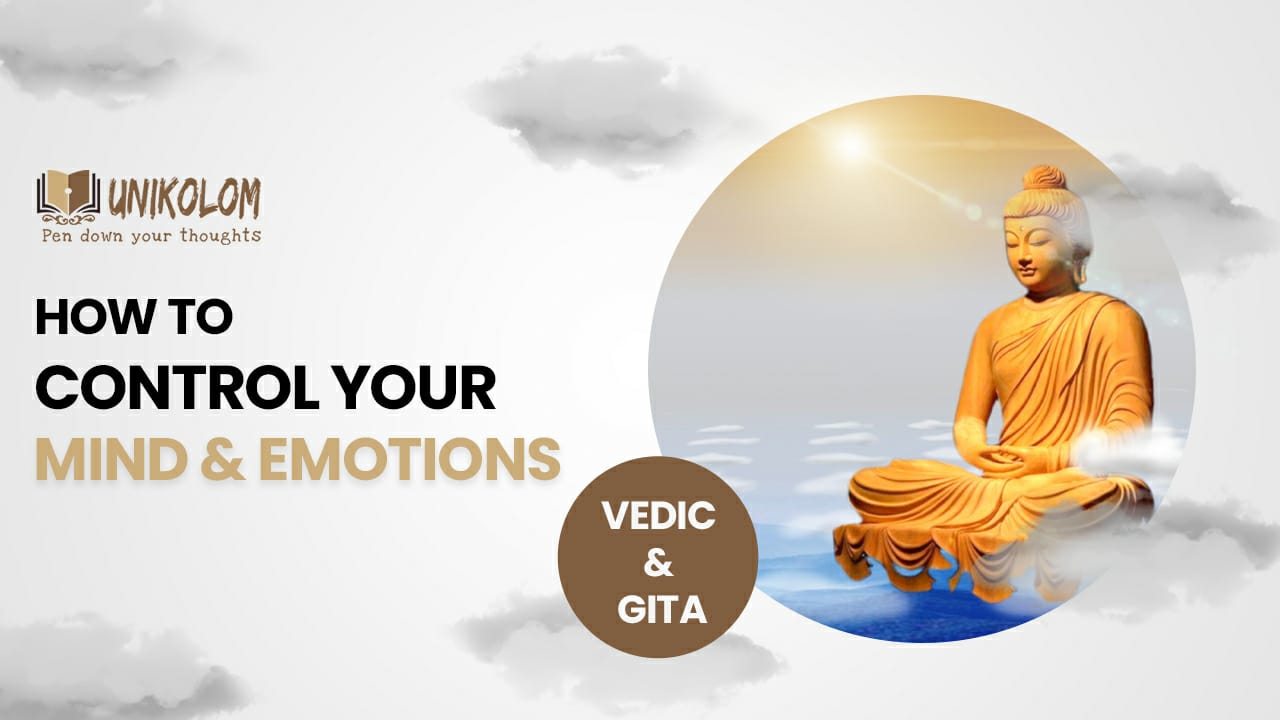Often we find it difficult to deal with a situation, traumatic or emotional. It affects our balance, workflow and disturbs our focus. Our mind is a unique system that harbors an infinite number of senses and feelings. Because the mind is inherently restless and uncontrollable, it must be disciplined in order to maintain its commitment to spirituality.
Why is it difficult to control the mind?
Often times we fail to acknowledge how we feel. We lack consciousness and a sense of self. We merely live and act on reflexes. We cannot get enough of the dopamine rush. However, unlike machines, human beings cannot live on auto-pilot and have a fulfilling life. We are oftentimes a slave to our desires. Every time we stress, we eat or find unhealthy ways to cope with stress via smoking or consumption of alcohol. Every time we give in to our impulses and feelings we move further away from controlling our minds and life.
Let’s dive deep into the ancient scriptures and texts of the Bhagavat Gita to understand the concept a bit better, from a unique aspect .
Sense objects and Vairagya : Importance of controlling the mind
Senses tether the mind to the objects of our senses through desire, which causes the restlessness of the mind. It follows that stabilizing the mind requires controlling the senses and cultivating detachment or “vairagya,” or separation from sense objects. We encounter this prescription in the verses below. (Chapter II, Verses 58-64)
The person whose senses can be completely withheld from sense objects, as a tortoise can withhold its limbs, has achieved mastery.”
He who practices abstinence ceases to be tortured by sense objects, but he retains a taste for them in his mind. The only way to get rid of it completely is to experience the transcendental life.
Even someone with complete knowledge of discrimination and attempts to control it will be thrown out of balance by the senses.
In those who are in charge of all the senses and establish them in me, his intelligence is stabilized.
Through constant attention to what one senses, one develops an attachment to that which one perceives. Attachment breeds desire, and desire leads to anger.
Anger in turn leads to delusion and disease.
A person can gain God’s mercy by freeing themselves of passion and dispassion and by keeping their senses under strict control and following the dictates of their inner soul.”
Techniques of Controlling the Mind According to the Gita
Practice and Non-attachment
“Asamsayam mahabaho mano durnigraham calam
Abhyasena to kaunteya vairagyena ca grhyate.”
“Surely, O mighty-armed one, the mind is restless and hard to control but by practice and non-attachment, O son of Kunti, it can be controlled.”
In this dialogue between Arjuna and Lord Krishna, we get an insight into the Lord’s guidance towards controlling the mind.
Arjuna had described the restless nature of the mind in Shlokas 33 and 34 of Chapter 6 of The Bhagavad-Gita, telling the Lord that the mind is as hard to control as the wind. The Lord explains the technique to Arjuna in the above-cited shloka of controlling the mind. But first, Arjuna acknowledges that the mind is hard to control, and the Lord gives us two important ways to do so via Arjuna. There are two components: practice and non-attachment.
Non Attachment: Where to start from
Psychology tells us that human beings are more motivated to perform a task if it’s associated with a purpose. The first step towards practicing detachment is acknowledging the deleterious effects of attachment and what meaning it has added to one’s life.
By seeking worldly attachments, what had your mind accomplished? Are you more in pain than in pleasure? Do any worldly relations have no selfish motives? What has ever given you everlasting pleasure in this world? Remember how suffering you have undergone because of attachments. When all attachments to the world are put down through discrimination, you will see that the mind slowly but surely becomes under control.
asaṅyatātmanā yogo duṣhprāpa iti me matiḥ
vaśhyātmanā tu yatatā śhakyo ’vāptum upāyataḥ
An individual whose mind is unbridled will have a difficult time achieving Yog. It is, however, possible to reach perfection in Yog if one has learned to control the mind and has endeavored with the correct means. It’s my opinion.
When a person becomes impervious to all desires because of disciplined living, he is said to be established in yoga.
Yoga practitioners whose minds are under control and who are united with their inner selves can be described as being like a lamp in a windless place
With the practice of meditation and mindfulness one is able to connect to their inner self. They raise their vibration and attain the higher self. However one needs to understand the concept, the correct way and purpose of meditation without which it would be like performing a task without understanding its utility. Meditation is more than the removal of all thoughts. It is the attempt to acknowledge the thought but having the power to return back to the state of peace devoid of thoughts and urges.
Persistence
Arjuna uvacha
Ayatih shraddhayopeto yogach chalita-manasah
Aprapya yoga-sansiddhim kan gatim krishna gachchhati
In order to achieve God-realization, one must have śhraddhā (faith). By virtue of their past lives, their associations with saints, or reversals in the world, sincere souls develop faith in the divine knowledge of the scriptures. The necessity of starting a journey may be created by a number of reasons. Yet, if they do not exert enough effort and become ayati (lax), their minds remain chalit (restless). The journey of such aspirants will not be completed in this lifetime.
